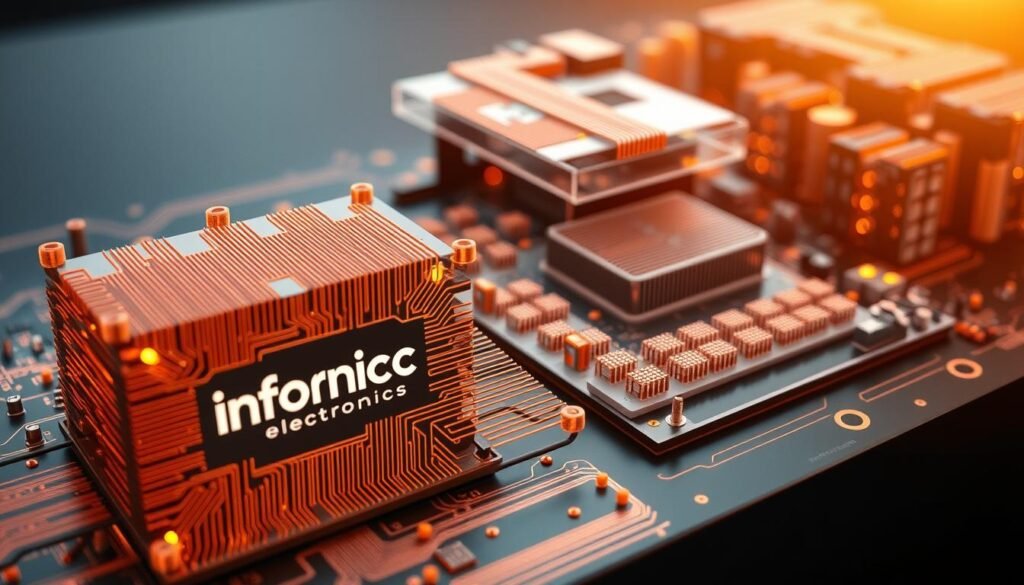What if the backbone of next-gen connectivity isn’t software or hardware—but what connects them? As networks evolve to support faster data speeds and near-instant responses, the unsung hero lies in the intricate web of circuits that make it all possible.
We’ve seen firsthand how millimeter wave frequencies demand unprecedented precision. Traditional designs struggle with signal loss at these speeds, creating bottlenecks for industries relying on real-time connectivity. The push for smaller components collides with the need for flawless performance—a puzzle requiring fresh thinking.
Our experience shows success hinges on five pillars: optimizing signal pathways, managing heat in tight spaces, shielding against interference, simplifying complex layouts, and maintaining microscopic accuracy during production. These aren’t just technical hurdles—they’re business-critical factors shaping product viability.
The stakes keep rising. Telecom providers, automakers, and IoT developers all race to leverage faster networks, creating explosive growth for specialized solutions. We’ve partnered with innovators to rethink materials, testing protocols, and assembly methods—proving that smarter approaches yield reliable results.
Key Takeaways
- High-frequency systems require radical redesigns to prevent signal degradation
- Thermal management becomes critical in compact device architectures
- EMI shielding strategies must evolve for dense electronic environments
- Advanced simulation tools reduce prototyping costs and timelines
- Collaborative partnerships accelerate problem-solving across supply chains
Overview of 5G Equipment PCBA Manufacturing Challenges
Next-generation networks demand more than incremental upgrades—they require reimagined foundations. We’ve witnessed firsthand how frequency jumps from 600 MHz to 77GHz create unique challenges in signal management. Devices now handle bandwidth channels spanning 100MHz below 6GHz to 400MHz above, pushing traditional pcb designs beyond their limits.
Industry Impact and Requirements
From smart factories to autonomous vehicles, multiple sectors face tighter reliability standards. Medical devices require flawless operation in EMI-heavy environments, while automotive systems need vibration-resistant solutions. These diverse requirements drive innovations in material science and production techniques.
“The market shift toward millimeter waves isn’t just about speed—it’s about enabling entirely new use cases.”
Technical Demands in Next-Generation PCBs
Modern pcbs must balance conflicting priorities:
| Feature | 4G Systems | 5G Demands |
|---|---|---|
| Max Frequency | 5.925 GHz | 77 GHz |
| Bandwidth Channels | 20-40 MHz | 400 MHz |
| Component Density | Standard | 10x Increase |
This evolution requires advanced fabrication methods that maintain signal integrity while packing more capabilities into shrinking form factors. Our team addresses these hurdles through hybrid materials and intelligent layout optimization, proving that smarter engineering unlocks next-level performance.
Design Challenges and Signal Integrity Optimization
Modern high-frequency systems demand designs that act like precision instruments rather than conventional boards. At speeds where data travels in picoseconds, every micron of copper and dielectric choice becomes critical. We approach these challenges through three lenses: physics-based modeling, material innovation, and production-ready validation.
Maintaining Signal Quality
Preserving clean transmissions requires rethinking layout fundamentals. Our team uses curved trace routing instead of right angles to minimize reflections. We pair this with strategic decoupling capacitor placement near power pins, reducing noise by up to 40% in recent projects.
Simulation tools reveal hidden issues early. By modeling electromagnetic behavior across frequencies, we identify crosstalk risks before prototyping. This proactive approach cut rework cycles by 58% for a recent millimeter-wave sensor project.
Impedance Control Strategies
Consistent impedance forms the backbone of reliable high-speed designs. Our methodology combines:
| Parameter | Traditional Approach | Modern Solution |
|---|---|---|
| Trace Tolerance | ±15% | ±5% |
| Dielectric Variation | 10% | 2% |
| Surface Roughness | 0.5µm | 0.1µm |
“Signal integrity isn’t just about avoiding errors—it’s about maximizing the information-carrying capacity of every square millimeter.”
We achieve these tight tolerances through semi-additive processes. This technique builds copper traces atom-by-atom, creating straighter walls than traditional etching. Combined with low-loss laminates, it maintains impedance stability across temperature swings.
Layer stack-up configuration completes the picture. By alternating signal layers with dedicated ground planes, we create predictable return paths. This reduces EMI while preserving signal clarity at multi-gigabit speeds.
Thermal Management in High-Speed PCB Designs

Every circuit board becomes a miniature furnace when pushing data at extreme speeds. We solve this paradox through layered strategies that balance physics with practical engineering. Effective thermal control determines whether advanced electronics survive their own performance demands.
Techniques for Effective Heat Dissipation
Strategic copper placement forms the foundation of thermal control. Our team uses thermal vias beneath power-hungry components, creating vertical escape routes for trapped energy. Combined with conductive pads, this approach reduces hotspot temperatures by 25-40% in compact layouts.
Material selection proves equally critical. We prioritize substrates with thermal conductivity above 1.5 W/mK while maintaining stable dielectric properties. Recent projects using ceramic-filled polymers show 30% better heat distribution than standard FR-4 alternatives.
Implementing Advanced Cooling Solutions
Modern designs demand hybrid approaches. Our cooling matrix combines:
| Solution | Benefit | Use Case |
|---|---|---|
| Phase-change materials | Absorbs 3x more heat | RF power amplifiers |
| Microchannel cooling | 40% density increase | Server-grade boards |
| Active airflow systems | Precision zone control | Edge computing nodes |
“Thermal design isn’t about removing heat—it’s about orchestrating its flow.”
Simulation tools predict thermal behavior before production. Our models account for copper thickness variations down to 2µm, ensuring real-world performance matches digital prototypes. This proactive approach eliminates 65% of thermal-related redesigns.
EMI/EMC Compliance and Shielding Techniques

Electromagnetic chaos threatens every modern circuit board operating in dense electronic environments. We tackle this invisible adversary through layered defense strategies that protect data transmission quality while meeting strict regulatory standards. Our approach transforms shielding from an afterthought into a core design principle.
Grounding and Filtering Best Practices
Solid ground planes form the foundation of clean signal paths. We create continuous copper layers that provide low-impedance return paths, reducing electromagnetic interference between devices by 60% in recent wireless communication projects. Strategic placement of decoupling capacitors near power pins further suppresses noise.
Filtering solutions adapt to frequency demands:
- Ferrite beads absorb high-frequency ripple currents
- Pi filters block unwanted harmonics
- Common-mode chokes neutralize differential noise
Mitigating Cross-Talk and Interference
Trace separation becomes critical when analog and digital circuits share space. Our team enforces strict zoning rules:
| Signal Type | Minimum Spacing | Shielding Method |
|---|---|---|
| RF (>1GHz) | 8x trace width | Guarded traces |
| Digital | 3x trace width | Ground plane isolation |
“Effective shielding isn’t about brute force—it’s about intelligent containment.”
Multilayer boards with dedicated power planes prevent capacitive coupling. We combine this with edge plating techniques that reduce radiation loss by 45%, ensuring reliable operation in interference-heavy environments.
Innovative PCB Design Practices for 5G Applications
Complexity becomes opportunity when approached with the right design philosophy. We treat every circuit board like a city plan—optimizing traffic flow while expanding capacity. Our strategies transform physical constraints into performance advantages through intelligent layout engineering.
Advanced Routing and Layout Techniques
Modern pcbs demand three-dimensional thinking. Our team employs microvia arrays that tunnel through 12+ layers, creating vertical highways for high-speed signals. This approach reduces path lengths by 60% compared to traditional through-hole vias.
| Feature | Traditional Design | Modern Solution |
|---|---|---|
| Via Type | Through-hole | Stacked Microvias |
| Layer Utilization | 6-8 layers | 12-16 layers |
| Trace Width | 100µm | 40µm |
| Flex Capability | Rigid Only | 5000+ bend cycles |
Flexible boards require specialized material stacks. We combine polyimide substrates with rolled copper to achieve 0.1mm bend radii—ideal for wearable health monitors and foldable displays. These technologies maintain signal integrity even when twisted 180 degrees.
“The future belongs to designs that disappear into devices while expanding their capabilities.”
Our simulation tools predict electromagnetic behavior across 77GHz frequencies. By modeling crosstalk risks early, we achieve 98% first-pass success rates. This precision enables overcoming design hurdles that stall less-equipped teams.
Material science drives breakthroughs. Low-loss dielectrics with 0.002 dissipation factors minimize heating in dense layouts. We pair these with silver-filled thermal adhesives that conduct heat 5x better than standard epoxies—crucial for maintaining quality in compact 5G modules.
Manufacturing Excellence and Material Innovations
Precision in production determines whether cutting-edge designs translate into reliable technology. We’ve redefined standards through strategic partnerships and material science breakthroughs, ensuring every board meets rigorous performance demands.
Adopting Modified Semi-Additive Processes
Traditional etching techniques struggle with modern trace density requirements. Our semi-additive approach builds copper pathways atom by atom, achieving 15µm line widths with ±2% tolerance. This method eliminates undercutting issues common in subtractive methods, preserving signal clarity across multi-layer stacks.
Precision Fabrication Guidelines
Material selection drives success in high-frequency environments. We combine low-loss laminates with ceramic-filled substrates for optimal thermal stability. Automated inspection systems verify alignment within 5µm, while laser-drilled microvias maintain consistent impedance from edge to center.
Recent advancements in advanced fabrication methods demonstrate how hybrid material stacks reduce insertion loss by 40% compared to conventional designs. These solutions enable complex layouts without compromising durability—critical for applications demanding millimeter-wave precision.
FAQ
How do circuit boards maintain signal integrity in high-frequency 5G systems?
What thermal management strategies work best for mmWave PCBs?
How are modern PCBs addressing EMI challenges in dense 5G arrays?
What material innovations improve performance in phased-array antenna boards?
How does automated optical inspection adapt to complex 5G PCB layouts?
What design rules prevent cross-talk in mixed-signal baseband processing boards?
About The Author
Elena Tang
Hi, I’m Elena Tang, founder of ESPCBA. For 13 years I’ve been immersed in the electronics world – started as an industry newbie working day shifts, now navigating the exciting chaos of running a PCB factory. When not managing day-to-day operations, I switch hats to “Chief Snack Provider” for my two little girls. Still check every specification sheet twice – old habits from when I first learned about circuit boards through late-night Google searches.
